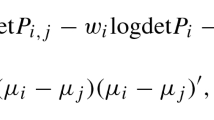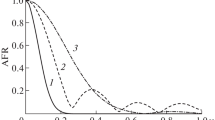Abstract
The Expectation–Maximization (EM) algorithm is a very popular technique for maximum likelihood estimation in incomplete data models. When the expectation step cannot be performed in closed form, a stochastic approximation of EM (SAEM) can be used. Under very general conditions, the authors have shown that the attractive stationary points of the SAEM algorithm correspond to the global and local maxima of the observed likelihood. In order to avoid convergence towards a local maxima, a simulated annealing version of SAEM is proposed. An illustrative application to the convolution model for estimating the coefficients of the filter is given.
Similar content being viewed by others
References
Amit, Y. and Grenander, U. (1991) Comparing sweep strategies for stochastic relaxation. Journal of Multivariate Analysis, 37, 197–222.
Arslan, O., Constable, P. and Kent (1993) Domains of convergence for the EM algorithm: a cautionary tale in a location estimation problem. Statistics and Computing, 3, 103–8.
Benveniste, A., Metivier, M. and Priouret, P. (1990) Adaptive Algorithms and Stochastic Approximations. Springer-Verlag.
Dempster, A., Laird, N. and Rubin, D. (1977) Maximum-likelihood from incomplete data via the EM algorithm. Journal of the Royal Statistical Society B, 39, 1–38.
Duflo, M. (1996) Algorithmes Stochastiques. Paris: SMAI, Springer.
Gelfand, S. and Mitter, S. (1993) Metropolis-type annealing algorithms for global optimization in Rd. SIAM Journal of Control and Optimization, 31, 1, 111–31.
Giannakis, G. and Mendel (1989) Identification of non-minimum phase systems using higher-order statistics. IEEE Transactions on Acoustic Speech and Signal Processing, 37, 360–77.
Kaleh, G. and Vallet, R. (1994) Joint parameters estimation and symbols detection for digital communication over linear or nonlinear unknown channels. IEEE Transaction on Communications, 7, 2406–13.
Kesten, H. (1958) Accelareted stochastic approximation. Annals of Mathematics and Statistics, 29, 41–59.
Lavielle, M. (1991) 2-D Bayesian deconvolution. Geophysics, 56, 12, 2008–18.
Lavielle, M. and Moulines, E. (1995) On a stochastic approximation version of the EM algorithm. Technical Report Publication Université Paris-Sud.
Mendel (1983) Optimal Seismic Deconvolution. New York: Academic Press Inc.
Nikias, C. and Mendel (1993) Signal processing with higher-order spectra. IEEE Signal Processing Magazine, 3, 10–37.
Polyak, B. (1990) New stochastic approximation type procedures. Automatica i Telemekh. (translated in Automatic & Remote Control), 51, 98–107.
Tanner, M. (1993) Tools for Statistical Inference: Methods for Exploration of Posterior Distributions and Likelihood Functions. Springer-Verlag: Springer series in statistics.
Wei, G. and Tanner, M. (1990) A Monte-Carlo implementation of the EM algorithm and the Poor's Man's data augmentation algorithm. Journal of the American Statistical Association, 85, 699–704.
Wu, C. (1983) On the convergence property of the EM algorithm. The Annals of Statistics, 11, 95–103.
Author information
Authors and Affiliations
Rights and permissions
About this article
Cite this article
Lavielle, M., Moulines, E. A simulated annealing version of the EM algorithm for non-Gaussian deconvolution. Statistics and Computing 7, 229–236 (1997). https://doi.org/10.1023/A:1018594320699
Issue Date:
DOI: https://doi.org/10.1023/A:1018594320699




